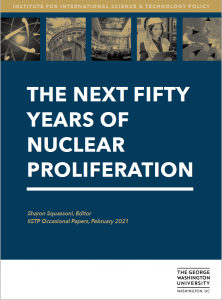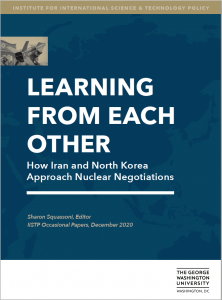Principal Investigator Sharon Squassoni Publishes Latest Edited Volume:
The Next Fifty Years of Nuclear Proliferation
The Nuclear Boundaries Initiative has aimed to identify areas of US and international nuclear policy and practice where equities overlap and yet are typically treated as separate, distinct issues. In the case of forecasts regarding nuclear weapons proliferation, analyses tend to focus on the strength of the Nuclear Nonproliferation Treaty, national export control and supplier control regimes and nuclear technology trends. This volume certainly covers those issues, but also speculates on how developments in other key areas — missiles, missile defenses, arms control, and emerging technologies – could affect nuclear weapons proliferation. In the world of US policy implementation, nonproliferation experts typically do not overlap with arms control specialists, and traditional analyses treat the problems and solutions as very different from each other. In countries with fewer resources, such stovepiping would be a luxury and, if we consider a trajectory of fewer and fewer nuclear weapons into the future, such stovepiping will be a detriment to a comprehensive solution to eliminating the risk of nuclear weapons.
Table of Contents
PREFACE AND ACKNOWLEDGEMENTS
3
INTRODUCTION:
JENNIFER KNOX AND SHARON SQUASSONI
4
ESSAYS:
Toward an Assessment of Future Proliferation Risk
MARK HIBBS
7
Nuclear Weapons Modernization and Future Proliferation Triggers
HANS M. KRISTENSEN
21
The Outlook for the Nuclear Nonproliferation Treaty
REBECCA DAVIS GIBBONS
35
HENRY SOKOLSKI
45
Nuclear Cooperation and Political Influence
COREY HINDERSTEIN
52
Reducing Demand-Side Pressure on Proliferation
JON B. WOLFSTHAL
60
Extended Deterrence and Nonproliferation
WILLIAM TOBEY
71
Crossing the Nonproliferation-Disarmament Divide
ADAM M. SCHEINMAN
83
The Next 50 Years of Missile Proliferation
XU TIANRAN AND MELISSA HANHAM
94
Missile Defense and Nuclear Weapons: Charting A Course To Security
LAURA GREGO
105
More to See and More to Hide: Forecasting the Effect of Space Technology on Nuclear-Weapon Issues
ROBERT S. WILSON
117
Steep Hill Ahead: US-Russia-China Relations and Their Impact on Nonproliferation
DAVID SANTORO
129
Knocking NuclearWeapons Off Their Pedestal: Emerging Technologies and the Future of Proliferation
ANKIT PANDA
142
BIOGRAPHIES
152
New Edited Volume For Nuclear Boundaries Initiative:
Learning From Each Other: How Iran and North Korea Approach Nuclear Negotiations
With the recent publication of her edited volume Learning From Each Other: How Iran and North Korea Approach Nuclear Negotiations, Research Professor Sharon Squassoni adds important insight to the debate on policymaking vis-a-vis Iran and North Korea.
The collection of essays published in Learning From Each Other is part of a broader project funded by the John D. and Catherine T. MacArthur Foundation called the Nuclear Boundaries Initiative. The Nuclear Boundaries Initiative has aimed to identify areas of U.S. and international nuclear policy and practice where equities overlap and yet are typically treated as separate, distinct policy issues. Although North Korea and Iran were once classified as “rogue states” posing the threat of nuclear proliferation, they have diverged in their paths in the last twenty years. Should they be treated as proliferating states using the same policy objectives, tools and approaches? Or should they be treated as distinctly separate problems? There are costs and benefits to these different approaches.
This set of essays is not meant to be definitive but offers a range of views on answering some of these questions. Its focus is not on whether the two states are mimicking each other or even cooperating in the development of ballistic missiles and nuclear weapons. The hope is that future U.S. policies can be crafted with more sensitivity to how they are perceived by the targets of their attention.

